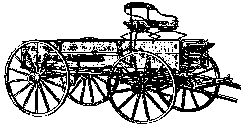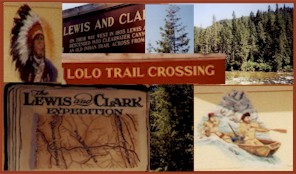8ARTICLE
DIGGERS DISCOVER EXPLORER'
(LEWIS & CLARK) LATRINE
Lewiston Morning Tribune
Associated Press
Monday, July 22, 2002
This page was last updated: February 1, 2010
Copyright © 2000 Larson Century Ranch, Inc. ~ All Rights Reserved
P. O. Box 1982
Clarkston, WA 99403
Telephone: 509-758-5445
FAX: 509-758-5701







 LOLO, Montana - Archaeologists have uncovered what they believe is the latrine used by the Lewis and Clark Corps of Discovery at their Travelers' Rest Campsite almost 200 years ago.
LOLO, Montana - Archaeologists have uncovered what they believe is the latrine used by the Lewis and Clark Corps of Discovery at their Travelers' Rest Campsite almost 200 years ago.
 The site was found after two days of excavation in Travelers Rest State Park here.
The site was found after two days of excavation in Travelers Rest State Park here.
The discovery could be a substantial pointer in the search for the group's exact campsite along Lolo Creek. That search is part of an effort to place a national historic landmark on the site of the Lewis and Clark camp.
 "The national historic landmark for Traveler's Rest was established around the confluence of the Bitterroot River and Lolo Creek and does not include this site," said Loren Flynn, director of the organization that manages the park.
"The national historic landmark for Traveler's Rest was established around the confluence of the Bitterroot River and Lolo Creek and does not include this site," said Loren Flynn, director of the organization that manages the park.
 Flynn said finding the latrine is a significant piece of evidence in identifying the site as one of the expedition's camps. Very few such camps have been pinpointed.
Flynn said finding the latrine is a significant piece of evidence in identifying the site as one of the expedition's camps. Very few such camps have been pinpointed.
 "This fits with some ofthe other pieces and assumptions we were making," Flynn said.
"This fits with some ofthe other pieces and assumptions we were making," Flynn said.
 Archaeologists first believed the site was a latrine because its size and distance from remnants of fire heaarths fit military guidelnes for setting up a camp, which they believe the expedition foloowed.
Archaeologists first believed the site was a latrine because its size and distance from remnants of fire heaarths fit military guidelnes for setting up a camp, which they believe the expedition foloowed.
 "It's consistent with the pattern they're finding at the portage campsite near Great Falls," Flynn said.
"It's consistent with the pattern they're finding at the portage campsite near Great Falls," Flynn said.
 Daniel Hall, the historical archaeologish leading the research project, theorized that the latrine would contain traces of mercury from Dr. Rush's Thunderbolts, a widely used cure-all of the time that the corps carried. It was 60 percent mercury.
Daniel Hall, the historical archaeologish leading the research project, theorized that the latrine would contain traces of mercury from Dr. Rush's Thunderbolts, a widely used cure-all of the time that the corps carried. It was 60 percent mercury.
 Hall's crew found Lolo Creek sediment, mainly sand and gravel, sandwiching a 19 inch-deep layer of dark, silty soil with organic material.
Hall's crew found Lolo Creek sediment, mainly sand and gravel, sandwiching a 19 inch-deep layer of dark, silty soil with organic material.
 Tests found traces of mercury in the layer of dark soil, but none in the soil or gravel surrounding it.
Tests found traces of mercury in the layer of dark soil, but none in the soil or gravel surrounding it.
 "I'm excited about the find," Flynn said. "Finding mercury in the soil is one of the corner pieces of the puzzle in identifying the campsite and receiving national recognition for this important site."
"I'm excited about the find," Flynn said. "Finding mercury in the soil is one of the corner pieces of the puzzle in identifying the campsite and receiving national recognition for this important site."







